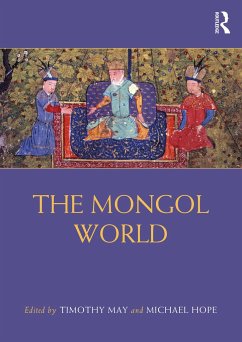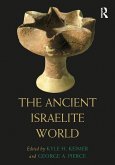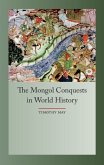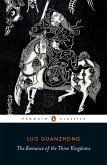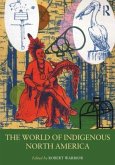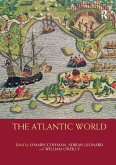The Mongol World
Herausgeber: Hope, Michael; May, Timothy
The Mongol World
Herausgeber: Hope, Michael; May, Timothy
- Gebundenes Buch
- Merkliste
- Auf die Merkliste
- Bewerten Bewerten
- Teilen
- Produkt teilen
- Produkterinnerung
- Produkterinnerung
Drawing upon research carried out in several different languages and across a variety of disciplines, The Mongol World documents how Mongol rule shaped the trajectory of Eurasian history from Central Europe to the Korean Peninsula, from the thirteenth century to the fifteenth century.
Andere Kunden interessierten sich auch für
![The Mongol World The Mongol World]() The Mongol World49,99 €
The Mongol World49,99 €![The Ancient Israelite World The Ancient Israelite World]() The Ancient Israelite World267,99 €
The Ancient Israelite World267,99 €![The Mongol Conquest in World History The Mongol Conquest in World History]() Timothy MayThe Mongol Conquest in World History48,99 €
Timothy MayThe Mongol Conquest in World History48,99 €![The Routledge Atlas of Russian History The Routledge Atlas of Russian History]() Martin GilbertThe Routledge Atlas of Russian History28,99 €
Martin GilbertThe Routledge Atlas of Russian History28,99 €![The Romance of the Three Kingdoms The Romance of the Three Kingdoms]() Luo GuanzhongThe Romance of the Three Kingdoms15,99 €
Luo GuanzhongThe Romance of the Three Kingdoms15,99 €![The World of Indigenous North America The World of Indigenous North America]() The World of Indigenous North America330,99 €
The World of Indigenous North America330,99 €![The Atlantic World The Atlantic World]() The Atlantic World54,99 €
The Atlantic World54,99 €-
-
-
Drawing upon research carried out in several different languages and across a variety of disciplines, The Mongol World documents how Mongol rule shaped the trajectory of Eurasian history from Central Europe to the Korean Peninsula, from the thirteenth century to the fifteenth century.
Hinweis: Dieser Artikel kann nur an eine deutsche Lieferadresse ausgeliefert werden.
Hinweis: Dieser Artikel kann nur an eine deutsche Lieferadresse ausgeliefert werden.
Produktdetails
- Produktdetails
- Routledge Worlds
- Verlag: Taylor & Francis Ltd
- Seitenzahl: 1068
- Erscheinungstermin: 26. Mai 2022
- Englisch
- Abmessung: 250mm x 176mm x 64mm
- Gewicht: 2102g
- ISBN-13: 9781138056671
- ISBN-10: 1138056677
- Artikelnr.: 62953166
- Herstellerkennzeichnung
- Libri GmbH
- Europaallee 1
- 36244 Bad Hersfeld
- gpsr@libri.de
- Routledge Worlds
- Verlag: Taylor & Francis Ltd
- Seitenzahl: 1068
- Erscheinungstermin: 26. Mai 2022
- Englisch
- Abmessung: 250mm x 176mm x 64mm
- Gewicht: 2102g
- ISBN-13: 9781138056671
- ISBN-10: 1138056677
- Artikelnr.: 62953166
- Herstellerkennzeichnung
- Libri GmbH
- Europaallee 1
- 36244 Bad Hersfeld
- gpsr@libri.de
Timothy May (Ph.D., University of Wisconsin-Madison) is Professor of Central Eurasian History at the University of North Georgia and serves as Associate Dean of Arts & Letters. A scholar of the Mongol Empire, he focuses on Mongol military history and strategy. He is the author of The Mongol Art of War (2007), The Mongol Conquests in World History (2012), The Mongol Empire (2018), The Mongols (2019), and Simply Chinggis (2021). In 2014, he was named the University of North Georgia Alumni Distinguished Professor, and he earned the UNG Distinguished Teaching Award in 2021. Michael Hope (Ph.D., Australian National University) is Associate Professor of History at Yonsei University, Korea. He specializes in the political and cultural history of the Mongol Empire with a particular focus on the Ilkhanate. He is the author of Power, Politics, and Tradition in the Mongol Empire and the Ilkhanate of Iran (2016).
Introduction Section 1: Conquest & State Formation Section 1 Introduction :
Conquest & State Formation Part 1: Chinggis Khan & State Formation 1.
Mongolia Before Chinggis Khan 2. The Rise of Chinggis Khan 3. The Early
Mongol State Part 2: The Mongol Conquests 4. The Mongol Conquest of Xi Xia
5. The Mongol Conquest of the Jin Empire, 1211-1234 6. The Mongol Conquest
of the Song Empire, 1234-1279 7. The Conquest of Qara Khitai and Western
Siberia 8. Conquest of the Dasht-i Qipchaq 9. The Mongol Conquest of Rus'
10. The Mongol Invasions of Europe 11. The Mongol Conquest of Iran 12. The
Mongol Conquest of Transcaucasia 13. The Mongol Conquest of the Near East
Part 3: The Mongol Successor States 14. The Jochid Ulus 15. The Yuan Empire
16. The Ilkhanate 17. The Middle Empire Part 4: Administration and
Political Structure 18. The Yasa 19. Jarqu and Jarquchin 20. Daughters,
Consort Families, and the Military 21. Mongol State Formation and Imperial
Transformation 22. The Keshig 23. The Jam System Section 2 The Social
History of the Mongol Empire Section 2 Introduction Part 5: Family and
Royal Households 24. Consort Families in the Successor States 25. Elite
Women in the Mongol Empire Part 6: Finance, Trade, & Economy 26. Mongol
Monetary Trends 27. Maritime Silk Road: The Mongols & the Indian Ocean 28.
Taxation in the Jochid Ulus 29. Overland Trade in the Mongol World Part 7:
Archaeology and Art History 30. The Archaeology of the Mongol Empire 31.
The Art History and Material Culture of the Yuan Empire 32. The Visual
World of the Ilkhanids and Chaghadaids 33. Archaeology and the Material
Culture of the Ulus Jochi (Golden Horde) Part 8: Religion 34. Shamans at
the Court of the Qa'an 35. Nestorian Christianity Among the Mongols 36. The
Islamization of the Mongols 37. Daoism in the Mongol Empire 38.
Confucianism in the Mongol Empire 39. Buddhism in the Mongol Empire 40.
Judaism and the Mongol Empire Part 9: Science & Exploration 41. Arabic
Medicine in China and in the Mongol World 42. Mapping & Exploration
Section 3 The Mongols in World History Section 3 Introduction Part 10 The
Mongols in the Eyes of the Conquered 43. Yuan Chinese Attitudes Towards the
Mongols 44. The Mongols in the Eyes of the Armenians 45. The Mongols in the
Eyes of the Koryo People 46. The Mongols in the Eyes of the Uyghurs
47. From Brutes to Bodhisattvas: The Mongols in Tibetan Sources 48. The
Mongols in the Eyes of the Iranians 49. The Mongols in the Eyes of the Rus'
50. The Mongols in the Eyes of the Papal & Royal Missions to Mongolia and
China (c. 1245-1370) Part 11: Beyond the Borders of the Mongol Empire 51.
Mongols in the Mamluk Sultanate 52. The Outer Limits of Steppe Power:
Mongol Excursions in Southeast Asia 53. The Mongols in South Asia 54. The
Mongol Invasions of Japan and Their Legacy Part 12: The Mongol Legacy 55.
The Chinggisid Legacy in the Middle East 56. Timur's Empire 57. Rescuing
Legitimate Narrative by Re-imaging Qubilai Qa'an 58. The Legacy of the
Mongol Empire in Mongolia
Conquest & State Formation Part 1: Chinggis Khan & State Formation 1.
Mongolia Before Chinggis Khan 2. The Rise of Chinggis Khan 3. The Early
Mongol State Part 2: The Mongol Conquests 4. The Mongol Conquest of Xi Xia
5. The Mongol Conquest of the Jin Empire, 1211-1234 6. The Mongol Conquest
of the Song Empire, 1234-1279 7. The Conquest of Qara Khitai and Western
Siberia 8. Conquest of the Dasht-i Qipchaq 9. The Mongol Conquest of Rus'
10. The Mongol Invasions of Europe 11. The Mongol Conquest of Iran 12. The
Mongol Conquest of Transcaucasia 13. The Mongol Conquest of the Near East
Part 3: The Mongol Successor States 14. The Jochid Ulus 15. The Yuan Empire
16. The Ilkhanate 17. The Middle Empire Part 4: Administration and
Political Structure 18. The Yasa 19. Jarqu and Jarquchin 20. Daughters,
Consort Families, and the Military 21. Mongol State Formation and Imperial
Transformation 22. The Keshig 23. The Jam System Section 2 The Social
History of the Mongol Empire Section 2 Introduction Part 5: Family and
Royal Households 24. Consort Families in the Successor States 25. Elite
Women in the Mongol Empire Part 6: Finance, Trade, & Economy 26. Mongol
Monetary Trends 27. Maritime Silk Road: The Mongols & the Indian Ocean 28.
Taxation in the Jochid Ulus 29. Overland Trade in the Mongol World Part 7:
Archaeology and Art History 30. The Archaeology of the Mongol Empire 31.
The Art History and Material Culture of the Yuan Empire 32. The Visual
World of the Ilkhanids and Chaghadaids 33. Archaeology and the Material
Culture of the Ulus Jochi (Golden Horde) Part 8: Religion 34. Shamans at
the Court of the Qa'an 35. Nestorian Christianity Among the Mongols 36. The
Islamization of the Mongols 37. Daoism in the Mongol Empire 38.
Confucianism in the Mongol Empire 39. Buddhism in the Mongol Empire 40.
Judaism and the Mongol Empire Part 9: Science & Exploration 41. Arabic
Medicine in China and in the Mongol World 42. Mapping & Exploration
Section 3 The Mongols in World History Section 3 Introduction Part 10 The
Mongols in the Eyes of the Conquered 43. Yuan Chinese Attitudes Towards the
Mongols 44. The Mongols in the Eyes of the Armenians 45. The Mongols in the
Eyes of the Koryo People 46. The Mongols in the Eyes of the Uyghurs
47. From Brutes to Bodhisattvas: The Mongols in Tibetan Sources 48. The
Mongols in the Eyes of the Iranians 49. The Mongols in the Eyes of the Rus'
50. The Mongols in the Eyes of the Papal & Royal Missions to Mongolia and
China (c. 1245-1370) Part 11: Beyond the Borders of the Mongol Empire 51.
Mongols in the Mamluk Sultanate 52. The Outer Limits of Steppe Power:
Mongol Excursions in Southeast Asia 53. The Mongols in South Asia 54. The
Mongol Invasions of Japan and Their Legacy Part 12: The Mongol Legacy 55.
The Chinggisid Legacy in the Middle East 56. Timur's Empire 57. Rescuing
Legitimate Narrative by Re-imaging Qubilai Qa'an 58. The Legacy of the
Mongol Empire in Mongolia
Introduction Section 1: Conquest & State Formation Section 1 Introduction :
Conquest & State Formation Part 1: Chinggis Khan & State Formation 1.
Mongolia Before Chinggis Khan 2. The Rise of Chinggis Khan 3. The Early
Mongol State Part 2: The Mongol Conquests 4. The Mongol Conquest of Xi Xia
5. The Mongol Conquest of the Jin Empire, 1211-1234 6. The Mongol Conquest
of the Song Empire, 1234-1279 7. The Conquest of Qara Khitai and Western
Siberia 8. Conquest of the Dasht-i Qipchaq 9. The Mongol Conquest of Rus'
10. The Mongol Invasions of Europe 11. The Mongol Conquest of Iran 12. The
Mongol Conquest of Transcaucasia 13. The Mongol Conquest of the Near East
Part 3: The Mongol Successor States 14. The Jochid Ulus 15. The Yuan Empire
16. The Ilkhanate 17. The Middle Empire Part 4: Administration and
Political Structure 18. The Yasa 19. Jarqu and Jarquchin 20. Daughters,
Consort Families, and the Military 21. Mongol State Formation and Imperial
Transformation 22. The Keshig 23. The Jam System Section 2 The Social
History of the Mongol Empire Section 2 Introduction Part 5: Family and
Royal Households 24. Consort Families in the Successor States 25. Elite
Women in the Mongol Empire Part 6: Finance, Trade, & Economy 26. Mongol
Monetary Trends 27. Maritime Silk Road: The Mongols & the Indian Ocean 28.
Taxation in the Jochid Ulus 29. Overland Trade in the Mongol World Part 7:
Archaeology and Art History 30. The Archaeology of the Mongol Empire 31.
The Art History and Material Culture of the Yuan Empire 32. The Visual
World of the Ilkhanids and Chaghadaids 33. Archaeology and the Material
Culture of the Ulus Jochi (Golden Horde) Part 8: Religion 34. Shamans at
the Court of the Qa'an 35. Nestorian Christianity Among the Mongols 36. The
Islamization of the Mongols 37. Daoism in the Mongol Empire 38.
Confucianism in the Mongol Empire 39. Buddhism in the Mongol Empire 40.
Judaism and the Mongol Empire Part 9: Science & Exploration 41. Arabic
Medicine in China and in the Mongol World 42. Mapping & Exploration
Section 3 The Mongols in World History Section 3 Introduction Part 10 The
Mongols in the Eyes of the Conquered 43. Yuan Chinese Attitudes Towards the
Mongols 44. The Mongols in the Eyes of the Armenians 45. The Mongols in the
Eyes of the Koryo People 46. The Mongols in the Eyes of the Uyghurs
47. From Brutes to Bodhisattvas: The Mongols in Tibetan Sources 48. The
Mongols in the Eyes of the Iranians 49. The Mongols in the Eyes of the Rus'
50. The Mongols in the Eyes of the Papal & Royal Missions to Mongolia and
China (c. 1245-1370) Part 11: Beyond the Borders of the Mongol Empire 51.
Mongols in the Mamluk Sultanate 52. The Outer Limits of Steppe Power:
Mongol Excursions in Southeast Asia 53. The Mongols in South Asia 54. The
Mongol Invasions of Japan and Their Legacy Part 12: The Mongol Legacy 55.
The Chinggisid Legacy in the Middle East 56. Timur's Empire 57. Rescuing
Legitimate Narrative by Re-imaging Qubilai Qa'an 58. The Legacy of the
Mongol Empire in Mongolia
Conquest & State Formation Part 1: Chinggis Khan & State Formation 1.
Mongolia Before Chinggis Khan 2. The Rise of Chinggis Khan 3. The Early
Mongol State Part 2: The Mongol Conquests 4. The Mongol Conquest of Xi Xia
5. The Mongol Conquest of the Jin Empire, 1211-1234 6. The Mongol Conquest
of the Song Empire, 1234-1279 7. The Conquest of Qara Khitai and Western
Siberia 8. Conquest of the Dasht-i Qipchaq 9. The Mongol Conquest of Rus'
10. The Mongol Invasions of Europe 11. The Mongol Conquest of Iran 12. The
Mongol Conquest of Transcaucasia 13. The Mongol Conquest of the Near East
Part 3: The Mongol Successor States 14. The Jochid Ulus 15. The Yuan Empire
16. The Ilkhanate 17. The Middle Empire Part 4: Administration and
Political Structure 18. The Yasa 19. Jarqu and Jarquchin 20. Daughters,
Consort Families, and the Military 21. Mongol State Formation and Imperial
Transformation 22. The Keshig 23. The Jam System Section 2 The Social
History of the Mongol Empire Section 2 Introduction Part 5: Family and
Royal Households 24. Consort Families in the Successor States 25. Elite
Women in the Mongol Empire Part 6: Finance, Trade, & Economy 26. Mongol
Monetary Trends 27. Maritime Silk Road: The Mongols & the Indian Ocean 28.
Taxation in the Jochid Ulus 29. Overland Trade in the Mongol World Part 7:
Archaeology and Art History 30. The Archaeology of the Mongol Empire 31.
The Art History and Material Culture of the Yuan Empire 32. The Visual
World of the Ilkhanids and Chaghadaids 33. Archaeology and the Material
Culture of the Ulus Jochi (Golden Horde) Part 8: Religion 34. Shamans at
the Court of the Qa'an 35. Nestorian Christianity Among the Mongols 36. The
Islamization of the Mongols 37. Daoism in the Mongol Empire 38.
Confucianism in the Mongol Empire 39. Buddhism in the Mongol Empire 40.
Judaism and the Mongol Empire Part 9: Science & Exploration 41. Arabic
Medicine in China and in the Mongol World 42. Mapping & Exploration
Section 3 The Mongols in World History Section 3 Introduction Part 10 The
Mongols in the Eyes of the Conquered 43. Yuan Chinese Attitudes Towards the
Mongols 44. The Mongols in the Eyes of the Armenians 45. The Mongols in the
Eyes of the Koryo People 46. The Mongols in the Eyes of the Uyghurs
47. From Brutes to Bodhisattvas: The Mongols in Tibetan Sources 48. The
Mongols in the Eyes of the Iranians 49. The Mongols in the Eyes of the Rus'
50. The Mongols in the Eyes of the Papal & Royal Missions to Mongolia and
China (c. 1245-1370) Part 11: Beyond the Borders of the Mongol Empire 51.
Mongols in the Mamluk Sultanate 52. The Outer Limits of Steppe Power:
Mongol Excursions in Southeast Asia 53. The Mongols in South Asia 54. The
Mongol Invasions of Japan and Their Legacy Part 12: The Mongol Legacy 55.
The Chinggisid Legacy in the Middle East 56. Timur's Empire 57. Rescuing
Legitimate Narrative by Re-imaging Qubilai Qa'an 58. The Legacy of the
Mongol Empire in Mongolia

